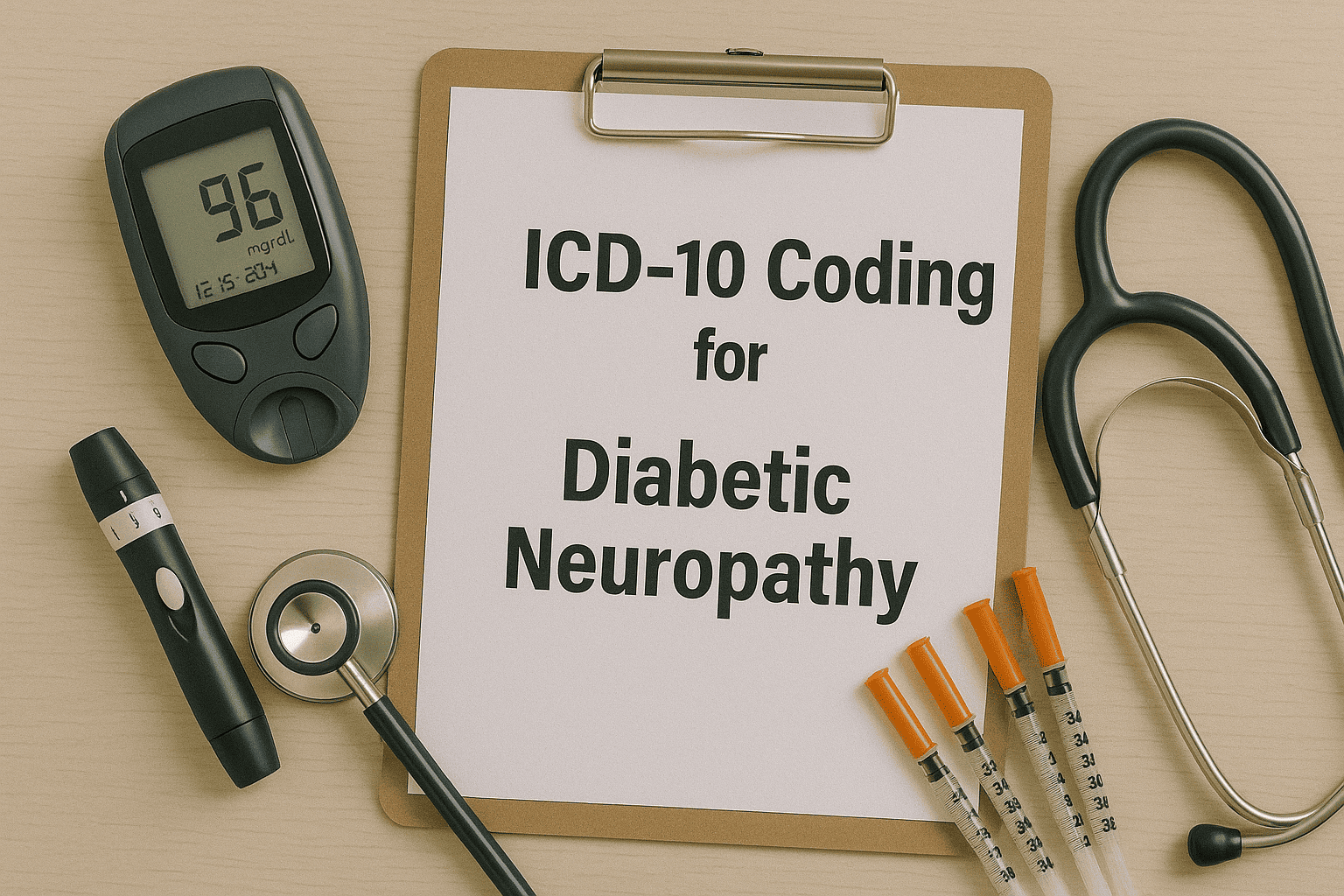Updated on: July 23, 2025
Diabetic Neuropathy is one of the most common and debilitating complications of long-standing diabetes. It not only affects patient quality of life but also demands meticulous documentation for accurate ICD-10 coding, reimbursement, and clinical continuity.
In this guide, we’ll break down the types of diabetic neuropathy, clinical workflows, ICD-10 coding examples, and how AI-powered tools like DocScrib can revolutionize documentation in real-time—without adding to your charting burden.
🔗 Visit DocScrib for AI-driven medical documentation made easy.
What is Diabetic Neuropathy?
Diabetic Neuropathy refers to nerve damage caused by prolonged high blood sugar levels in people with diabetes. It typically develops slowly and can affect various parts of the nervous system.
Major Types of Diabetic Neuropathy
| Type | Description |
|---|---|
| Peripheral Neuropathy | Most common; affects feet and legs first |
| Autonomic Neuropathy | Affects GI tract, bladder, sexual function, heart |
| Focal Neuropathy | Sudden weakness in a nerve or group of nerves |
| Proximal Neuropathy | Affects hips, thighs, or buttocks; often one-sided |
🧠 Clinical Tip: Peripheral neuropathy is the most frequently encountered type in outpatient settings. Always screen diabetic patients for sensory symptoms—even if asymptomatic.
Common Symptoms to Watch For
-
Burning, tingling, or numbness in feet/hands
-
Muscle weakness or loss of reflexes
-
Difficulty with coordination or walking
-
Changes in digestion, urination, or sexual response (autonomic)
-
Unexplained pain or weakness (focal)
Red Flag: Foot ulcers or injuries with no pain → screen for peripheral sensory loss urgently.
ICD-10 Coding for Diabetic Neuropathy
Getting ICD-10 coding right is essential for compliance, reimbursement, and quality metrics. Here’s how to code diabetic neuropathy based on the type and documentation available.
Core ICD-10 Codes for Diabetic Neuropathy
| Diagnosis | ICD-10 Code | Description |
|---|---|---|
| Type 2 diabetes with diabetic neuropathy | E11.40 | With unspecified diabetic neuropathy |
| Type 2 diabetes with peripheral neuropathy | E11.42 | Most common outpatient neuropathy code |
| Type 1 diabetes with peripheral neuropathy | E10.42 | Use for Type 1 diabetic patients |
| Diabetic autonomic neuropathy | E11.43 | For GI/bladder/sexual/autonomic symptoms |
| Diabetic neuropathic arthropathy | E11.610 | For Charcot joint due to diabetic neuropathy |
🔍 Pro Tip: Always specify the type of diabetes and the exact nature of the neuropathy to avoid undercoding.
Case Example: Documenting and Coding Diabetic Neuropathy
Scenario:
A 67-year-old male with a 15-year history of Type 2 diabetes complains of tingling in both feet, worsening at night. No ulcers. Monofilament test shows reduced sensation.
Traditional Approach:
-
Manual SOAP note entry
-
Search for ICD-10 codes
-
Potentially incomplete or inconsistent documentation
DocScrib Approach:
✅ AI auto-detects:
-
Type 2 diabetes
-
Peripheral neuropathy symptoms
-
Clinical exam results
✅ Suggests ICD-10: E11.42
AI-Generated Note (via DocScrib):
S: Patient reports 6-month history of tingling and numbness in both feet, worse at night.
O: Monofilament test shows reduced sensation bilaterally; no foot ulcers.
A: Type 2 diabetes mellitus with diabetic peripheral neuropathy (E11.42)
P: Start gabapentin 300 mg qhs. Refer to podiatry. Educate on foot care.
📥 One-click export. No missed codes. EHR ready.
Why Accurate Documentation of Diabetic Neuropathy Matters
| Clinical Reason | Impact |
|---|---|
| Risk stratification | Improves outcomes for foot care, falls, hospitalizations |
| Chronic condition coding | Enhances HCC risk adjustment in Medicare Advantage |
| Specialty referrals | Supports podiatry, neurology, or pain management |
| Reimbursement accuracy | Reduces claim denials and coding audits |
| Quality care metrics | Supports diabetic foot exams, preventive care ratings |
Benefits of Using DocScrib for Chronic Condition Documentation
| Feature | Without DocScrib | With DocScrib |
|---|---|---|
| ICD-10 Code Suggestions | Manual lookup | ✅ Auto-suggested from patient context |
| Chronic Condition Tracking | Inconsistent | ✅ Continuously tracked |
| Neuropathy Symptom Recognition | Missed in notes | ✅ Auto-flagged for coding |
| SOAP Note Generation | Time-consuming | ✅ Done in real-time |
| Referral Documentation | Often skipped | ✅ Suggested with diagnostic plan |
💬 “I save up to 2 hours a day just on chronic documentation. DocScrib makes neuropathy notes accurate and compliant.”
— Primary Care Physician, Texas
FAQs: Diabetic Neuropathy & ICD-10 Coding
Q1: Should I always use E11.42 for diabetic neuropathy in Type 2 patients?
Yes, if symptoms and clinical findings support peripheral neuropathy, E11.42 is the most specific code.
Q2: What if the patient has multiple types of neuropathy?
You can use multiple codes (e.g., E11.42 for peripheral + E11.43 for autonomic) when clearly documented.
Q3: What if the diabetes is not under control?
The coding remains the same (e.g., E11.42), but document A1C trends, med adherence, and complications.
Q4: Does DocScrib support HCC coding for neuropathy?
Yes. DocScrib suggests risk-adjusted chronic condition codes and ensures documentation matches billing requirements.
Final Thoughts: Make Neuropathy Documentation Effortless
Diabetic neuropathy affects millions—and documenting it properly impacts clinical quality, coding accuracy, and patient safety. Whether you’re managing this in primary care, endocrinology, or geriatrics, the documentation load doesn’t have to slow you down.
With DocScrib, you get:
-
AI-assisted SOAP notes
-
Smart ICD-10 code recommendations
-
Real-time symptom recognition
-
Improved chronic disease tracking
🎯 Ready to simplify your neuropathy documentation?
🔗 Visit DocScrib.com
📅 Schedule Your Free Demo and start documenting smarter, not harder.
